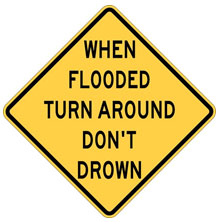It would be an understatement to say that so far this year weather incidents including tornados, hurricanes and earthquakes has been one for the record books. The good news is, depending on where you live the likelihood of you experiencing one of these horrific events first hand is hopefully low.
Do you know what the most common weather catastrophe is in the United States and Canada? It’s Floods. Floods can happen any time and any place – you don’t necessarily have to live by a body of water. Do you have an emergency plan for your family and pets in the event of a flood warning? After surveying our Sparkle Wash office team, I found out that no one had an emergency plan! I am taking this opportunity to share the recommended Flood information from Ready, the U.S government disaster planning website.
Know your Risk
What
Flooding is a temporary overflowing of water onto land that is normally dry. Flooding may happen with only a few inches of water, or it may cover a house to the rooftop. There are many possible causes of floods including heavy rain or snowmelt, coastal storms and storm surge, waterway overflow from being blocked with debris or ice, or overflow of levees, dams, or waste water systems, Flooding can occur slowly over many days or happen very quickly with little or no warning, called flash floods.
Where
Flooding can happen in any U.S. state or territory. It is particularly important to be prepared for flooding if you live in a low-lying area near a body of water, such as near a river, stream, or culvert; along a coast; or downstream from a dam or levee.
When
Flooding can occur during every season, but some areas of the country are at greater risk at certain times of the year. Coastal areas are at greater risk for flooding during hurricane season (i.e., June to November), while the Midwest is more at risk in the spring and during heavy summer rains. Ice jams occur in the spring in the Northeast and Northwest. Even the deserts of the Southwest are at risk during the late summer monsoon season.
Basic Safety Tips
- Turn Around, Don’t Drown! ®
- Avoid walking or driving through flood waters.
- Do not drive over bridges that are over fast-moving floodwaters. Floodwaters can scour foundation material from around the footings and make the bridge unstable.
- Just 6 inches of moving water can knock you down, and one foot of moving water can sweep your vehicle away.
- If there is a chance of flash flooding, move immediately to higher ground.
- If floodwaters rise around your car but the water is not moving, abandon the car and move to higher ground. Do not leave the car and enter moving water.
- Avoid camping or parking along streams, rivers, and creeks during heavy rainfall. These areas can flood quickly and with little warning.
Flood watch
Flood Watch = “Be Aware.” Conditions are right for flooding to occur in your area.
Steps to Take
- Turn on your TV/radio. You will receive the latest weather updates and emergency instructions.
- Know where to go. You may need to reach higher ground quickly and on foot.
- Build or restock your emergency preparedness kit. Include a flashlight, batteries, cash, and first aid supplies.
Prepare Your Home
- Bring in outdoor furniture and move important indoor items to the highest possible floor. This will help protect them from flood damage.
- Disconnect electrical appliances and do not touch electrical equipment if you are wet or standing in water. You could be electrocuted.
- If instructed, turn off your gas and electricity at the main switch or valve. This helps prevent fires and explosions.
Flood warning
Flood Warning = “Take Action!” Flooding is either happening or will happen shortly.
Steps to Take
- Move immediately to higher ground or stay on high ground.
- Evacuate if directed.
- Avoid walking or driving through flood waters. Turn Around, Don’t Drown! Just 6 inches of moving water can knock you down and one foot of moving water can sweep your vehicle away.
After a flood
- Return home only when authorities say it is safe.
- Be aware of areas where floodwaters have receded and watch out for debris. Floodwaters often erode roads and walkways.
- Do not attempt to drive through areas that are still flooded.
- Avoid standing water as it may be electrically charged from underground or downed power lines.
- Photograph damage to your property for insurance purposes.
When it is not flooding: Make a flood plan
- Familiarize yourself with local emergency plans. Know where to go and how to get there should you need to get to higher ground, the highest level of a building, or to evacuate.
- Make a flood emergency plan for the relevant type/s of local flood risk with plans such as evacuation, shelter, locations for high ground.
- Build or restock your emergency preparedness kit, including a minimum of 3 days of food and water, flashlight, batteries, cash, and first aid supplies.
- Consider buying flood insurance.
- Stay tuned to your phone alerts, TV, or radio for weather updates, emergency instructions, or evacuation orders.
We hope this articles provides some insight into the preparation and planning it takes if a flood warning takes place. The Sparkle Wash team hopes you’ll never have to use any type of disaster plan.


Recent Comments